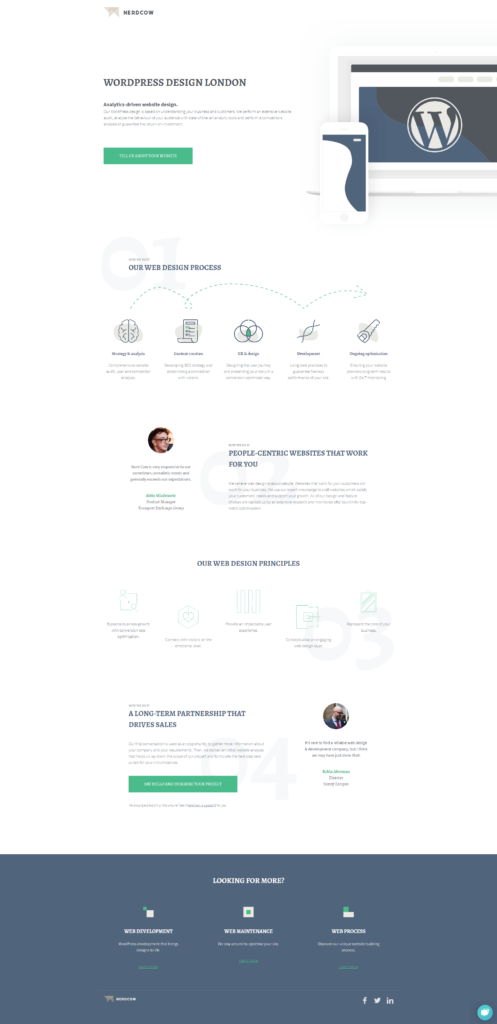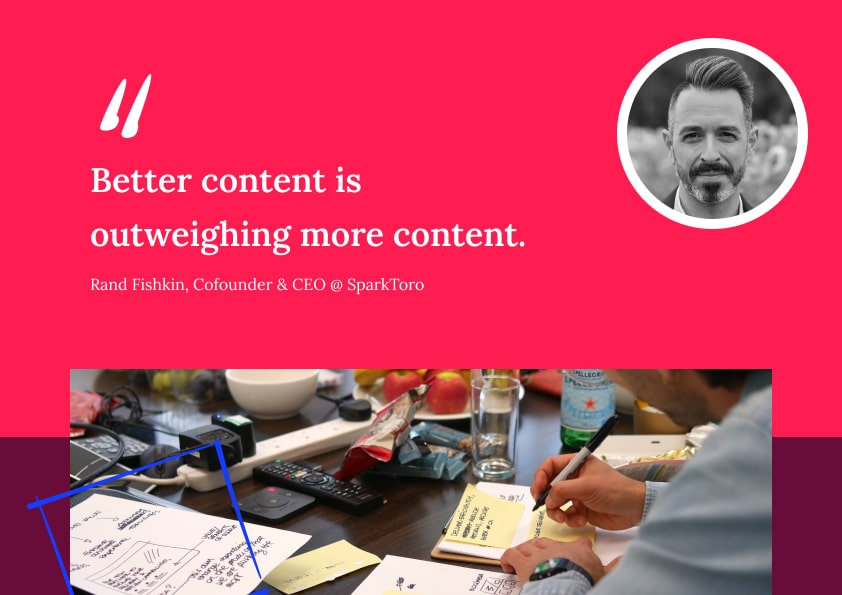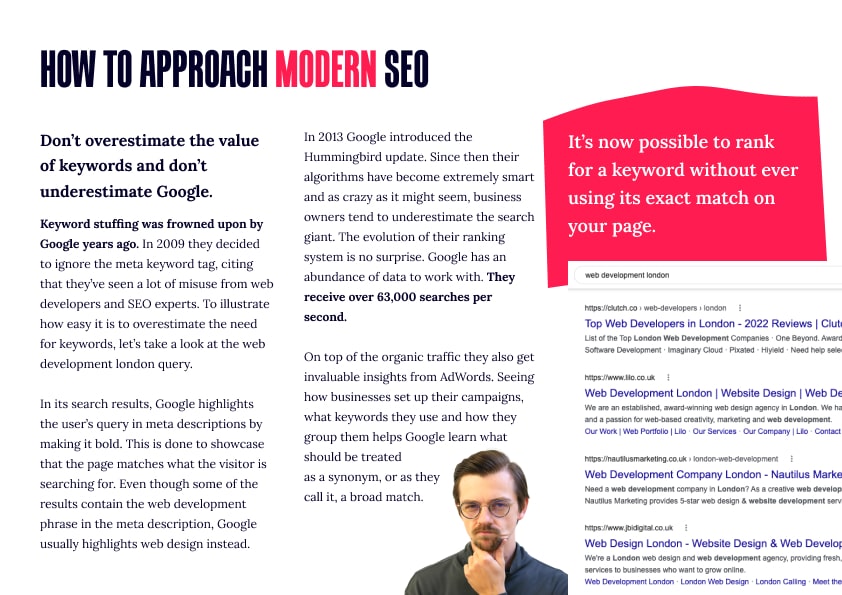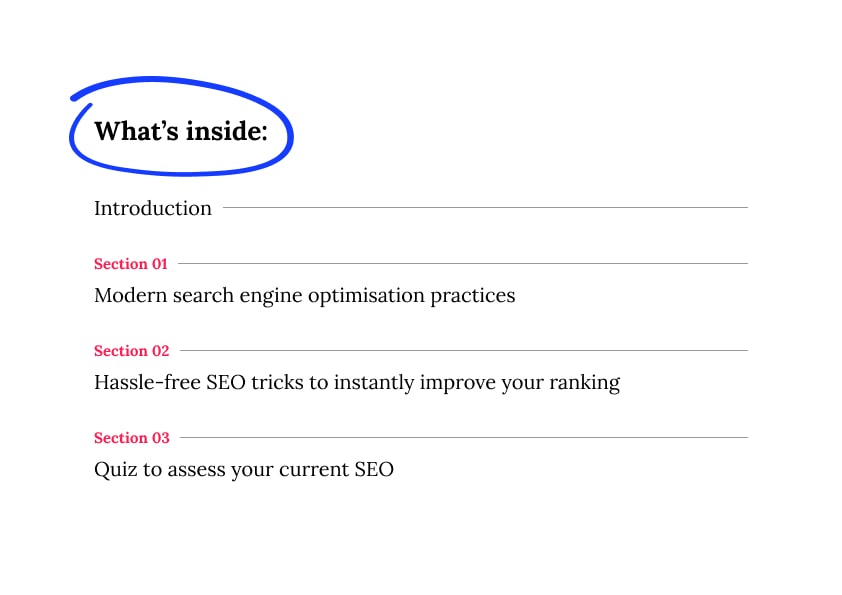How landing pages support your digital marketing
Digital marketing opened up an abundance of possibilities for businesses to reach their goals - from social media, through content creation, all the way to the search engine optimisation and paid advertising. But the online world still offers several underappreciated or simply unheard of practices that support business goals. In this article, we will show you the essentials of a highly flexible and cost-effective digital advertising tool - landing pages. Written by Dawid ZimnyWhat is a landing page?
A landing page is a standalone webpage optimised for conversions, usually with a single goal for the visitor. It’s a part of your website and but it’s virtually a separate entity.
Your entire website will have at least a few possible customer journeys, such as a purchase, filling a contact form, subscribing to a newsletter, and so on. Landing pages are limited to just one, maybe two goals.

When offering multiple services, the purchase process can consist of multiple funnels on its own, each related to the specific service or product. The unique features of your products and services might require a different approach to the structure of their individual pages, changing the intended customer journey.
So how do you make the most out of very specific paid advertising campaigns in that scenario? Or what if you’re releasing a product, such as an ebook, that requires a bespoke design? That’s where landing pages come in.
Landing page benefits
In these specific scenarios, landing pages have several benefits over creating a new page that’s in-line with your website’s design. Here’s a quick summary of the most important ones:
- increased organic traffic
- higher conversions of paid advertising campaigns
- precisely targeted content
- optimised customer journey
- foundation for easy and efficient data analysis
- fewer design boundaries
Why you should use landing pages
Landing pages for paid advertising
PPC campaigns, such as Google Ads, rely heavily on your landing page – and for a good reason. During the first stages of a new website build, you lay foundations for your website.
These foundations include aspects such as SEO keywords and funnels optimised for your target audience. But in most cases, the number of keywords is limited. User experience is now much more important than stuffing search phrases to satisfy search engine crawlers.
When you create Google Ads campaigns, you’ll notice that the performance of your ads relies not only on their copy but also on the landing page. You’ll find that using your core website pages for some ad groups simply won’t be optimal. That’s when you can create landing pages optimised for these groups.
On top of the aforementioned design freedom, you get to create content highly optimised for these keywords. Your landing page score in Google Ads improve and the conversions of these pages will be optimised for a highly targeted audience.
Driving organic traffic through landing pages
Generating organic traffic with just the core pages is challenging these days. Google rates the user experience above anything else. Stuffing your website with keywords might help you rank initially, but as soon as people visit your page and then leave because of poor user experience, Google will notice that and your ranking will decrease.
That’s one reason content marketing is very popular. Driving traffic through articles allows you to target a wide range of keywords while offering value to your visitors.
Landing pages give you a similar amount of freedom. Your landing pages don’t have to be used for paid advertising – they can simply be there to generate organic traffic. At the same time, the pages that you’ve already created for your PPC campaigns will drive organic traffic to your website even after your campaigns are over.
Avoid SEO mistakes with our FREE PDF
Sign up for our newsletter and get immediate access to “Outdated SEO Practices Marketers Should Avoid”, which includes a quiz to test your knowledge of SEO basics.
Easier performance analysis
Why have we mentioned that it’s easier and more efficient to analyse a landing page?
On a regular website, it’s often hard to attribute the visitor’s decision to a specific factor. What made the visitor abandon the process? Did they visit the About Us section because that’s what they’re looking for, or were they lost? With several distractions, it’s harder to judge.
Your landing page has one, maybe two call-to-action buttons. The customer journey is very short and straightforward. There’s no unnecessary navigation. Everything you put on your landing page is there to convert the visitor.
A/B testing
A/B testing is delivering different content to a portion of your visitors to test its performance. They range from small changes like different headline wording to design changes, such as different button placement or colour, and so on.
This is something that can (and should) be done on regular website pages. However, it’s once again much easier to track on landing pages. With fewer variables and a single goal, changing a page and seeing an increase in conversions is a clear sign that the tested version performs better.
The common landing page uses cases
Knowing why landing pages are so efficient you might ask “what do I put on my landing page?”
We’ve mentioned some examples already, but here’s a quick cheat sheet for the most popular activities:
- lead generation (often complemented by one of the below examples)
- increase brand awareness and improve its image
- new account registration
- product purchase
- ebook or resource download
- newsletter signup
- job application
- even registration
- customer survey
- coming soon page for your new website
…and many more.
We hope you’ve learned about the power of landing pages and the new knowledge will help you achieve your business goals in the digital space.
Why CRO Will More than Double Your Sales
Discover the value of optimising your conversions compared to building more landing pages or designing a new website.
Originally published Jul 25, 2019 9:30:13 AM, updated December 11 2023.






Join the conversation
Looking to share your feedback and join in on the conversation?